

What is Media Literacy and Why Does it Matter? Everyone from the President of the United States to a posh toddler can carry an iPhone and send off mass messages to hundreds and thousands of online influencers.
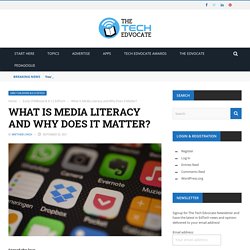
We connect at the touch of a button and make decisions with the flick of a wrist. As a result, it’s especially important for employees, students, influencers, and everyday users to have media literacy and understand the consequences that follow online actions. Educators have adapted to the times and incorporated media literacy skills into the educational standards of every state through a variety of subjects.
From language arts to mathematics, humanities, and social sciences, every curriculum can touch on digital messaging. No matter how media literacy is introduced, it’s important that educators help learners develop critical thinking skills, and understand the impact media messaging has on society. What is Media Literacy Critical Thinking Why does this matter? Self-Expression Civic Responsibility. Teaching Math with Technology: 8 Virtual Resources. 5 Math Technology Tools to Engage Students - Global Learning.
Next Generation Science Videos For K-8 - Generation Genius. Learning Math? 25 Of The Best Math Resources For 2020. By TeachThought Staff What are the best math resources?

Because of the skill-based nature of mathematics in general, math resources pair especially well with digital tools like apps and websites. On these kinds of platforms, accounts can be created, progress can be visualized, mastery can be documented, complexity can be adjusted to individual needs, and achievements can even be given as a kind of motivation mechanic. Year to year, the best math resources tend to stay the same, with large platforms like the Kahn Academy being supplemented by well-designed apps like Quizlet and Math Agent. Top 10 Tools For The Digital Classroom. There is certainly no shortage of tech-based tools to use in the classroom. In this article we’ll examine some of the best, focusing specifically on those that are designed for encouraging, enhancing, and managing learning. 1.
Socrative Socrative professes to be “your classroom app for fun, effective classroom engagement”. In a nutshell, it is a cloud-based student response system, allowing teachers to immediately test student understanding by way of mini-quizzes, assigned to them on class laptops or tablets. 2. Scratch is a simple, fun, and engaging introduction to programming, designed specifically for 8 to 16-year-olds. 3. 5 Simple Ways to Add Creativity in Mathematics. By Pronita Mehrotra In a study by the US Department of Education, 81% of 4th graders reported having a positive attitude towards mathematics, but that number drops significantly to 35% for 8th graders.

Somehow, in the span of four years, children lose their interest in the subject, and as a result, their performance declines. Bringing Joy to Math Class. It’s difficult to be a teacher today.

Between covering all the state standards, preparing students for state testing, conducting data analyses of student learning and our own progress as teachers, and providing evidence for evaluations, we have a lot on our plates—and I didn’t even mention preparing lessons, let alone teaching them. 50 Innovative Teaching Methods in Science. Student engagement and understanding of materials is given more emphasis in today’s education over spoon feeding the facts. Therefore, using black-boards or the typical lecture methods are not adequate to teach science and other related subjects. Creative, Flexible Mathematics with Jo Boaler. 36 Teaching Strategies to Try in 2020. One of the best qualities a teacher can have is a willingness to try new teaching strategies.In Effective Teaching and Learning, educational researcher Naga Subramani argues that an effective teacher: “Constantly renews himself [or herself] as a professional on his [or her] quest to provide students with the highest quality of education possible.
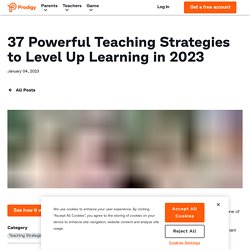
This teacher has no fear of learning new teaching strategies or incorporating new technologies into lessons.” Is that you? Try new teaching strategies with Prodigy, a no-cost, adaptive math platform. Get started today! There’s more than one way to teach a diverse and dynamic classroom. Classroom teaching strategies 1. [caption id="attachment_2138" align="alignnone" width="6250"] Infographic: 20 Classroom Management Strategies and Techniques. 2. 3.
Norman Webb’s Depth of Knowledge (DoK) is familiar to many teachers from a theoretical perspective, but it can be incredibly difficult to apply practically and consistently in your teaching strategies. 4. Teaching Math Through Creativity. According to Molly A.
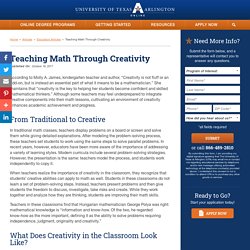
James, kindergarten teacher and author, “Creativity is not fluff or an add-on, but is instead an essential part of what it means to be a mathematician.” She maintains that “creativity is the key to helping her students become confident and skilled mathematical thinkers.” Although some teachers may feel underprepared to integrate creative components into their math lessons, cultivating an environment of creativity enhances academic achievement and progress.
In traditional math classes, teachers display problems on a board or screen and solve them while giving detailed explanations. After modeling the problem-solving process, these teachers set students to work using the same steps to solve parallel problems. Effective Technology Use in Math Class. Incorporating technology in mathematics classrooms enables educators to craft powerful collaborative learning experiences that support problem solving and flexible thinking.
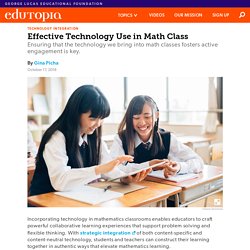
With strategic integration of both content-specific and content-neutral technology, students and teachers can construct their learning together in authentic ways that elevate mathematics learning. Until recently, one of educators’ primary concerns around educational technology was the lack of access that existed in many American schools. That gap has decreased, but a new digital divide has emerged: The updated 2017 National Education Technology Plan explains that in today’s classrooms many students are using technology as a tool for passive learning rather than engaging in active learning experiences that promote student agency. The Importance of Content-Specific Pedagogy. 8 Engaging Ways to use Technology in the Classroom to Create Lessons That Aren’t Boring. Are you tired of delivering the same old lectures on the same subjects year after year?
How to Integrate Technology. Below you will find a quick overview with suggestions of what kinds of tools and activities are best matched with various levels of technology access. All of the resources linked to are either free or offer free versions. If your class has an interactive whiteboard and projector: Try interactive websites such as BrainPOP.
Dig in to Scholastic's whiteboard activities page. Show online videos related to the lessons. If there is only one computer in your room: All of the above, plus… Assign one student to be the class scribe and take notes. 9 Unique Ways to use Technology in the Classroom. Essential Apps for the Physical and Digital K-12 Classroom. As educators face uncertainties this fall, it helps to focus on a few things that are certain.
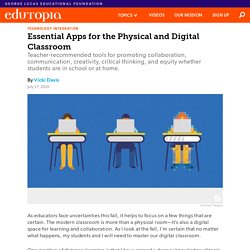
The modern classroom is more than a physical room—it’s also a digital space for learning and collaboration. As I look at the fall, I'm certain that no matter what happens, my students and I will need to master our digital classroom. One positive of distance learning is that I have gained a deeper knowledge of tools that work everywhere. The tools below are my personal favorites, ones that I recommend for everywhere learning this fall. It isn’t the tool that teaches, of course—it’s us. Differentiated Teaching. Incorporating & accounting for Social Media in Education. Using technology to sensitively and sensibly meet students' needs in the science classroom. This month, we are discussing why and how you should incorporate educational technology into your classroom, and we have rounded up our favorite educational technology tools that we are currently using to meet the learning needs of our diverse learners in our science classrooms.
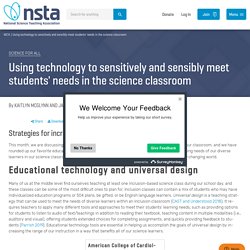
Finally, we have provided tips for you to keep up with this ever-changing world. Educational technology and universal design Many of us at the middle level find ourselves teaching at least one inclusion-based science class during our school day, and these classes can be some of the most difficult ones to plan for. Inclusion classes can contain a mix of students who may have individualized education programs or 504 plans, be gifted, or be English language learners.